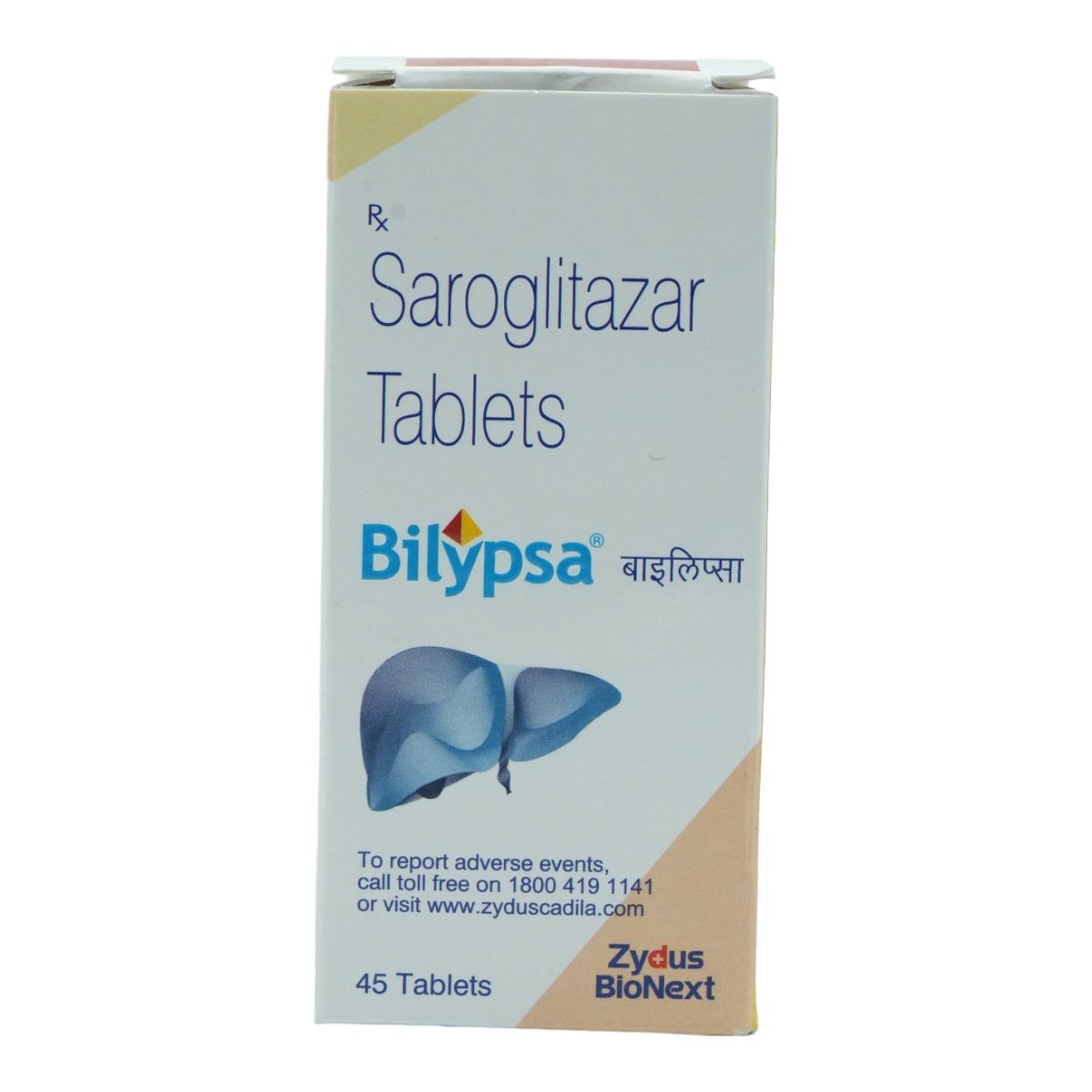Saroglitazar
About Saroglitazar
Saroglitazar is used to treat diabetic dyslipidemia (a condition characterized by increased triglyceride levels, low-density lipoproteins (LDL)) in type 2 diabetic patients, which is not controlled by statins (lipid-lowering agents) alone. Diabetic dyslipidaemia is characterised by increased triglyceride levels, low-density lipoproteins (LDL) and decreased high-density lipoprotein (HDL) levels. This condition is common in people with type-2 diabetes mellitus.
Saroglitazar contains Saroglitazar; it works in two ways in your body. It assists in lowering blood levels of harmful fats by reducing bad cholesterol. It improves insulin sensitivity, which helps regulate blood sugar levels by increasing your body's reactivity to insulin. Saroglitazar helps control blood sugar and cholesterol levels by performing these two things, which is particularly advantageous for diabetics
In some cases, you may experience certain common side effects, such as stomach inflammation, nausea, vomiting, weakness, chest discomfort, dizziness, and fever. Most of these side effects do not require medical attention and will resolve gradually over time. However, you are recommended to consult your doctor if you experience these side effects persistently.
Take Saroglitazar as advised. Your physician will decide the dosage based on your medical condition. You can take Saroglitazar before the first meal or as advised by the doctor. It is recommended not to exceed the recommended dose of Saroglitazar. Do not chew, crush, or break the medicine. It is crucial to have your blood sugar levels checked regularly.
Inform your doctor if you are allergic to Saroglitazar or any other components present in it. Saroglitazar should be used with caution in patients with kidney or liver impairment and in elderly patients. Avoid alcohol consumption while taking Saroglitazar as it might cause unpleasant side effects. Consult your doctor if you are pregnant or breastfeeding. Saroglitazar should not be given to children as safety and effectiveness have not been established. Saroglitazar might cause dizziness, so drive with caution.
Uses of Saroglitazar
• Diabetic Dyslipidemia: Saroglitazar helps regulate cholesterol levels in people with diabetes by lowering triglycerides and LDL (bad cholesterol) while increasing HDL (good cholesterol).
• Hypertriglyceridemia: Saroglitazar reduces high triglyceride levels, which are linked to cardiovascular risks.
• Type 2 Diabetes Mellitus: Saroglitazar improves insulin sensitivity and helps control blood sugar levels.
• Non-Alcoholic Fatty Liver Disease (NAFLD): Saroglitazar helps in managing fat accumulation in liver cells, potentially preventing progression to more severe conditions.
Medicinal Benefits
1. Improves lipid profile
- Reduces triglyceride levels considerably.
- Reduces total cholesterol, LDL (bad cholesterol), VLDL, and non-HDL-C.
- Shows a modest increase in HDL-C (good cholesterol).
- Especially useful in diabetic and atherogenic dyslipidemia.
2. Glycemic Control
- Reduces HbA1c and fasting plasma glucose in type 2 diabetes.
- Useful in patients who require simultaneous management of glucose and cholesterol levels.
3. Non-alcoholic fatty liver disease (NAFLD) or NASH
- Emerging evidence supports its ability to improve liver enzymes (ALT, AST) and histology.
- Potentially beneficial in lowering hepatic steatosis and fibrosis.
4. Cardiometabolic Risk Reduction
- Improving cholesterol and glucose levels may minimize overall cardiovascular risk in diabetes people.
- However, long-term cardiovascular outcome investigations are either ongoing or limited.
Directions for Use
• Saroglitazar is to be taken before the first meal of the day, or as advised by the doctor. • Follow your doctor's instructions on the dosage and timing of this medication to ensure safety. • Swallow Saroglitazar as a whole with a glass of water. • Do not chew, crush or break it.
Storage
Side Effects of Saroglitazar
- Stomach inflammation
- Nausea
- Vomiting
- Weakness
- Chest discomfort
- Dizziness
- Fever
Drug Warnings
- Do not take Saroglitazar if you are allergic to any of the components.
- Inform your doctor if you notice rapid weight gain.
- Maintain caution if you have any history of kidney or liver impairment or use in elderly patients.
- Consult your doctor before taking Saroglitazar if you are pregnant. It is not known if Saroglitazar is excreted into breast milk; therefore, nursing mothers should avoid taking Saroglitazar while nursing.
- Saroglitazar should be used with caution in patients with type 2 diabetes who have cardiovascular disease.
- Saroglitazar is not recommended for use in children below 18 years of age, as safety and effectiveness have not been established.
- Saroglitazar might cause dizziness, so drive with caution. Avoid alcohol consumption while taking Saroglitazar as it might cause unpleasant side effects.
- It is always important to check the expiry date of the medicine. Discard the medicine if it reaches the expiry date.
Drug Interactions
Drug-Drug Interactions: No interactions found/established.
Drug-Food Interactions: No interactions found/established.
Drug-Disease Interactions: No interactions found/established.
Drug-Drug Interactions Checker List:
Safety Advice

Alcohol
unsafeYou are recommended to avoid alcohol consumption while taking Saroglitazar to prevent unpleasant side effects.

Pregnancy
consult your doctorSaroglitazar belongs to pregnancy category C. Consult your doctor before taking Saroglitazar if you are pregnant; your doctor will prescribe only if the benefits outweigh the risks.

Breast Feeding
unsafeNursing mothers should avoid taking Saroglitazar as it is not known if Saroglitazar is excreted into breastmilk.

Driving
cautionSaroglitazar may cause dizziness. Therefore, drive or operate machinery only if you are alert.

Liver
cautionSaroglitazar should be used with caution in patients with liver disease. Please consult your doctor if you have a liver impairment or any concerns regarding this.

Kidney
cautionSaroglitazar should be used with caution in patients with kidney disease. Please consult your doctor if you have kidney impairment or any concerns regarding this.

Children
unsafeSaroglitazar is not recommended for children as the safety and effectiveness have not been established.
Habit Forming
Diet & Lifestyle Advise
- Follow a cholesterol-lowering diet.
- Exercise regularly. It helps in maintaining proper weight and lowers cholesterol.
- Limit salt and sugar intake.
- Avoid smoking and alcohol consumption.
- Choose healthy fats and cut down on trans-fat.
- Include omega-3 fatty acids, fibre-rich food, fruits and vegetables.
- Get active by doing any physical activity such as swimming, brisk walking or jogging. Take stairs instead of elevators/lifts.
- Try eating food at regular intervals. Do not skip meals. Also, try not to overeat.
- Follow a healthy diet and walk for at least 45 minutes to complement treatment with Saroglitazar.
- Rest properly, avoid stress by doing meditation or yoga.
Patients Concern
Disease/Condition Glossary
Diabetic dyslipidaemia/hypertriglyceridemia: Diabetic dyslipidemia, also known as hypertriglyceridemia, is characterized by increased triglyceride levels, low-density lipoproteins (LDL) and decreased high-density lipoprotein (HDL) levels. This condition is common in people with type-2 diabetes mellitus. It is one of the major risk factors for cardiovascular disease in diabetic patients. Lifestyle, genetics, obesity, consumption of high saturated/trans fat, low thyroid levels, and kidney disease could be the cause of dyslipidaemia. Symptoms of diabetic dyslipidaemia include chest pain/tightness, indigestion, heartburn, dizziness, palpitations, shortness of breath, cold sweats, nausea, and vomiting.
FAQs
Saroglitazar is used to treat diabetic dyslipidaemia/hypertriglyceridemia in type-2 diabetic patients, which is not controlled by statins (lipid-lowering agents) alone.
Saroglitazar decreases triglycerides and LDL cholesterol and increases HDL cholesterol. It also helps in promoting glucose utilisation. Thereby, Saroglitazar improves insulin resistance and lowers blood triglycerides and blood glucose levels.
Saroglitazar does not cause weight gain or oedema. However, inform your doctor if you notice rapid weight gain. Your doctor might assess you for fluid accumulation, volume-related events such as oedema and congestive heart failure.
Do not stop taking Saroglitazar without consulting your doctor. To treat your condition effectually, continue taking Saroglitazar for as long as your doctor has prescribed it.
Saroglitazar can be taken by elderly patients if prescribed by the doctor. However, Saroglitazar should be used with caution in geriatric patients.
Consult your doctor before taking Saroglitazar if you have cardiac problems. If prescribed, Saroglitazar should be used with caution in patients with type-2 diabetes having heart-related problems with episodic congestive heart failure. Regular monitoring for signs and symptoms of congestive heart failure in such patients is advised.
Saroglitazar should be swallowed as a whole with water. Do not crush or chew it.
Saroglitazar should be taken during pregnancy if prescribed by the doctor. Please consult the doctor if you are pregnant or think you may be pregnant.
Nursing mothers should not use Saroglitazar as it is unknown if Saroglitazar is excreted into the breast milk.
Saroglitazar may cause common side effects like stomach inflammation, nausea, vomiting, weakness, chest discomfort, dizziness, and fever. Most of these side effects do not require medical attention and will resolve gradually over time. However, you are recommended to consult the doctor if any of the side effects persist or worsen.
You are recommended to avoid alcohol consumption while taking Saroglitazar to prevent unpleasant side effects.
Take the missed dose as soon as you remember. However, if it is almost time for the scheduled dose, skip the missed dose and take the scheduled dose at the regular time.
Saroglitazar may help increase HDL/good cholesterol and lower LDL/bad cholesterol.
Saroglitazar should not be taken by people who are allergic to any of its components. It should be used with caution in people with abnormal liver/kidney function or a history of myopathies (disease that affects skeletal muscles).





